Ever walked into a room and felt something was off, even with amazing decor? The problem might be the lighting. Good lighting can change a space from dull to welcoming. But how do you get the perfect lighting and ambiance for your home? Let’s explore the secrets to making your living space inviting and functional.
Key Takeaways
- Lighting should be approached in a layered manner to highlight architectural and design features.
- Proper lighting can create a cozy, inviting atmosphere and set the perfect mood for relaxation or entertainment.
- Understanding the different types of lighting, including task, accent, and ambient, is key to creating a well-lit space.
- Warm-colored lights contribute to a cozy and inviting atmosphere, while balance with lighting is essential for a visually appealing living space.
- Leveraging natural light can enhance the ambiance of a living room and make it feel more welcoming and spacious.
Understanding the Fundamentals of Lighting Design
Illumination design shapes the feel of a space. It’s about how light affects us. It looks at each room’s purpose and how light can improve it.
The Psychology of Light and Space
Lighting greatly affects our mood and how well we work. It can make a room feel warm, cozy, or lively. Changing light’s intensity, color, and where it comes from can change how we feel and act in a space.
Basic Principles of Illumination
- Identifying the primary purpose and activities within a room
- Determining the appropriate levels of task, accent, and ambient lighting
- Selecting the right light fixtures and lamp shades to achieve the desired illumination
- Considering the placement and direction of light sources to create a balanced and cohesive design
Impact on Mood and Behavior
Lighting deeply affects our mood and actions. Soft, warm light makes us feel calm, while bright, cool light helps us stay alert. Good lighting design makes spaces work better, saves energy, and boosts our well-being.
| Lighting Type | Purpose | Effect on Mood and Behavior |
|---|---|---|
| Task Lighting | Illumination for specific activities | Enhances focus and productivity |
| Accent Lighting | Highlights architectural features or artwork | Adds depth and visual interest to a space |
| Ambient Lighting | Provides overall illumination and sets the mood | Creates a cozy, inviting atmosphere |
“Lighting has the power to transform a space, influence mood, and enhance the overall functionality of a room. Understanding the fundamentals of illumination design is key to creating welcoming and balanced living spaces.”
The Three Essential Types of Interior Lighting
To get the perfect lighting in your home, you need to know about task lighting, accent lighting, and ambient lighting. Each type is key to a balanced and useful lighting setup. It makes your space look good and work well.
Ambient Lighting
Ambient lighting, or general lighting, lights up the whole room. It comes from ceiling lights, recessed lighting, table lamps, and more. This lighting sets the mood and helps with basic tasks.
Accent Lighting
Accent lighting highlights special areas in your space. It should be much brighter than the room’s overall light. This makes architectural features, artwork, and decor stand out. You can use recessed lighting, wall lights, and more for this.
Task Lighting
Task lighting is for specific activities, like reading or cooking. It includes under-cabinet lights, desk lamps, and wall sconces. This lighting makes sure you have enough light for detailed work.
By mixing these three types of lighting, you can make a space that looks great and works well. It’s all about balance and function.

“Lighting is the first and most important design element in any space, as it sets the tone and mood for the entire room.”
Mastering Lighting and Ambiance in Different Rooms
Creating the perfect lighting and ambiance for each room is key in interior design. From cozy living rooms to relaxing bedrooms, and functional kitchens, the right lighting changes the mood. It can transform any space.
Living Room Lighting Strategies
In the living room, mix ambient and accent lighting for a warm, inviting feel. Ambient lighting, like recessed lights or a central pendant, sets the base light. Accent lighting highlights special features or decor. 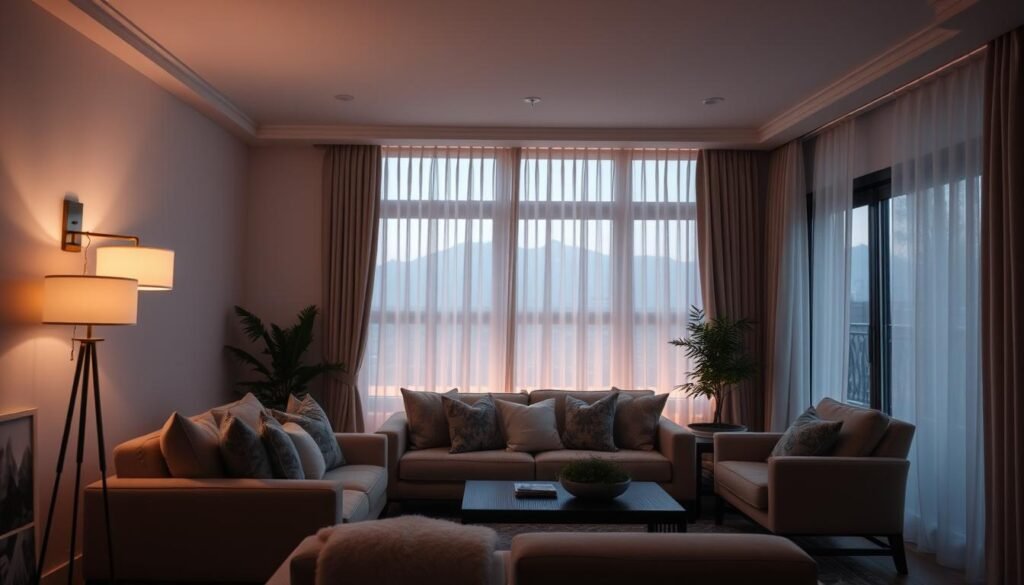 Floor and table lamps add to the mood, letting you adjust the light for any occasion.
Floor and table lamps add to the mood, letting you adjust the light for any occasion.
Bedroom Illumination Tips
In the bedroom, soft, intimate lighting is best. Dimmable overhead lighting or wall sconces create a calm, relaxing space. Add task lighting, like bedside lamps, for reading. Mood lighting and dimmer switches let you adjust the light for any time of day.
Kitchen and Dining Area Lighting
The kitchen and dining area need a mix of task lighting and ambient light. Bright task lighting, like under-cabinet lights or pendants, helps with food prep. Soft, mood-enhancing lighting in the dining area, from chandeliers or dimmable lights, makes meals more inviting.
Mastering lighting and ambiance in each room takes thought. It’s about layering lights and using dimmer switches and lighting control systems. This way, you create a space that’s both versatile and beautiful, fitting your lifestyle and tastes.
Smart Lighting Solutions for Modern Spaces
Interior lighting has changed a lot with smart lighting solutions. These systems let homeowners control the lighting for any mood. You can change brightness, color, and scenes with just a button or voice command.
Smart lighting makes life easier. You can manage it with apps or voice assistants like Alexa. This makes controlling your home’s lighting simple and saves energy.
Smart lights use LED tech, saving up to 75% energy compared to old lights. This means big savings on bills. Plus, motion sensors and timers turn off lights when not needed, saving even more.
Smart lighting also boosts security and work performance. It can make it seem like someone’s home, keeping burglars away. In offices, it can help workers focus and feel better.
Smart lighting is great for any need, from cozy evenings to saving money. With many options, you can change your space in many ways.
| Smart Lighting Features | Benefits |
|---|---|
| Adjustable brightness and color temperature | Allows users to set the perfect ambiance for any activity or mood |
| Pre-set lighting scenes | Enables quick and convenient control of lighting settings |
| Smartphone app and voice control | Offers hands-free management of lighting systems |
| Motion sensors and timed schedules | Contribute to energy efficiency by optimizing light usage |
| Integration with security and HVAC systems | Enhances safety, convenience, and overall home automation |
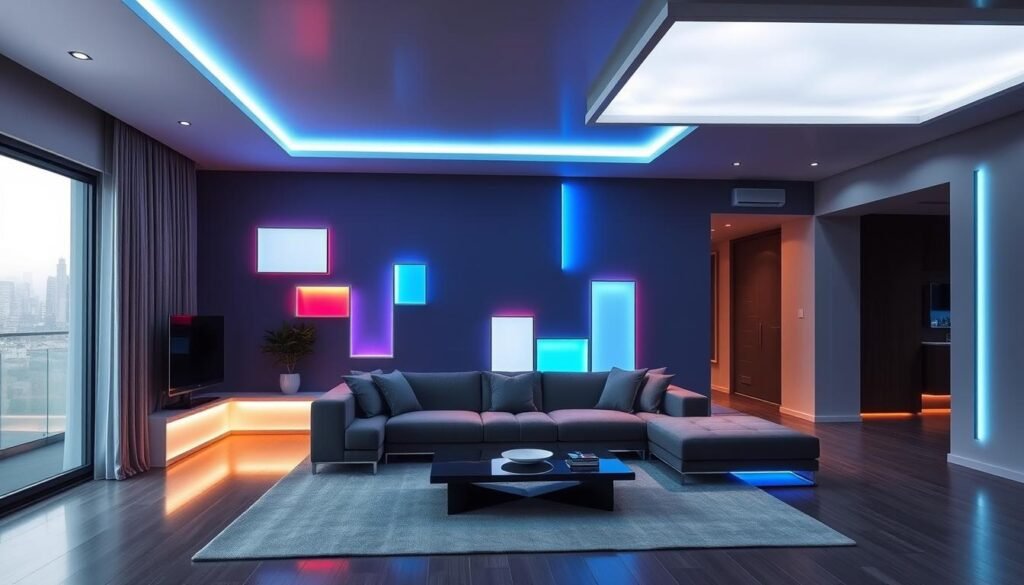
“Smart lighting systems have transformed the way we approach illumination, providing unmatched control and customization for our homes and workplaces.”
Natural Light Integration and Enhancement
Using natural light is key to making a space bright and welcoming. The sun’s power can greatly improve a room’s feel, energy use, and health. By adding natural light, you can boost the ambient lighting and illumination design of your area.
Window Treatment Options
Window treatments are important for managing natural light. Sheer curtains or drapes can soften sunlight while keeping things private. Mirrors can also spread light, making rooms feel brighter and more open.
Maximizing Daylight
Watching how light changes in a room is smart. Placing furniture and decor to catch the best light makes rooms welcoming all day. Light walls and shiny surfaces also help natural light work better.
Balancing Natural and Artificial Light
Finding the right mix of natural and artificial light is key. Adjusting artificial lights to match natural light changes makes a space look good all day.
| Benefit | Natural Light | Artificial Light |
|---|---|---|
| Energy Efficiency | Reduces reliance on artificial lighting, lowering energy consumption and costs. | Requires more energy usage, contributing to higher utility bills. |
| Health and Wellness | Exposure to natural light can boost mood, improve sleep, and regulate circadian rhythms. | Prolonged exposure to artificial lighting can disrupt sleep patterns and increase the risk of health issues. |
| Aesthetic Appeal | Natural light enhances the visual appeal of indoor spaces, highlighting architectural features and creating a warm, inviting atmosphere. | Artificial lighting can create harsh shadows and unnatural-looking environments if not properly balanced. |
By carefully mixing natural and artificial light, you can make a space that’s both beautiful and healthy. This approach improves well-being, saves energy, and looks great.
Choosing the Right Light Fixtures
Choosing the right light fixtures is key to creating the perfect atmosphere and function in any space. Each fixture, from pendant lights to table lamps, has its own role. They all help shape the look of a room.
Think about the room’s size, ceiling height, and the mood you want. Pendant lights are great above kitchen islands and dining areas. Chandeliers are perfect for entryways and dining rooms. Flush mounts are best for hallways and rooms with low ceilings.
Recessed lighting adds ambient light to big rooms and task light to kitchens and bathrooms. Track lighting is great for showing off artwork and adding accent light in kitchens. Wall sconces are good for hallways and beside mirrors. Table and floor lamps are common in living rooms and bedrooms.
| Fixture Type | Recommended Placement |
|---|---|
| Chandeliers | Entryways, foyers, dining rooms |
| Pendant Lights | Kitchen islands, dining areas |
| Flush Mounts | Hallways, low-ceiling rooms |
| Semi-Flush Mounts | Entryways, hallways |
| Recessed Lighting | Ambient lighting, task lighting in kitchens and bathrooms |
| Track Lighting | Accent lighting, artwork illumination, kitchens |
| Wall Sconces | Flanking mirrors, hallways |
| Table and Floor Lamps | Living rooms, bedrooms |
Mixing different light fixtures adds interest and ensures good lighting for all activities. By thinking about each room’s needs and design goals, you can pick the best light fixtures, lamp shades, and accent lighting. This will make your space look and feel great.
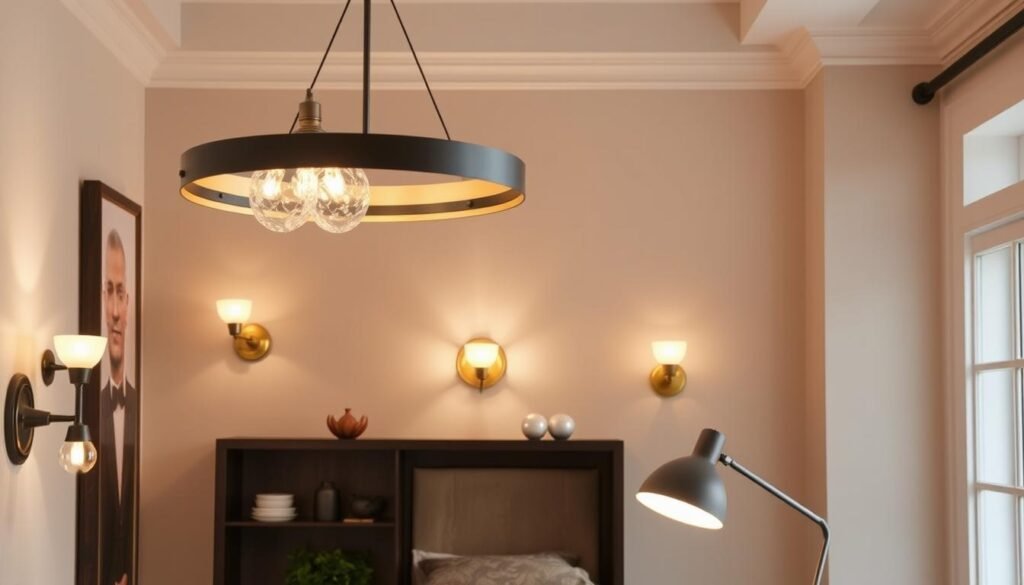
Color Temperature and Its Effects
Lighting greatly affects the mood and feel of any room. The color temperature of light, measured in Kelvin, plays a big role. Knowing about warm, neutral, and cool lighting helps you set the right mood in your home.
Warm vs. Cool Lighting
Warm lighting, with a Kelvin range of 2000K to 3500K, feels cozy and inviting. It has red, orange, and yellow tones, perfect for bedrooms and living rooms. On the other hand, cool lighting, from 5000K to 6500K, is bright and blue-white. It’s great for kitchens and home offices to stay alert and focused.
Seasonal Lighting Adjustments
Changing your lighting’s color temperature with the seasons keeps your space comfortable. In winter, warm lighting can make your home feel cozy. In summer, cool lighting keeps your space fresh and lively.
Creating Color Harmony
To have a beautiful lighting scheme, you need color harmony. Choose light bulbs that match your room’s colors and mood. This way, your lighting will enhance your home’s look and feel, smoothly connecting different areas.
| Color Temperature Range | Lighting Characteristics | Recommended Applications |
|---|---|---|
| 2000K – 3500K | Warm, cozy, and inviting | Bedrooms, living rooms, coffee shops, and bistros |
| 3500K – 5000K | Neutral, balanced, and natural | Laundry rooms, home offices, and retail spaces |
| 5000K – 6500K | Cool, bright, and stimulating | Kitchens, art galleries, and task-oriented areas |
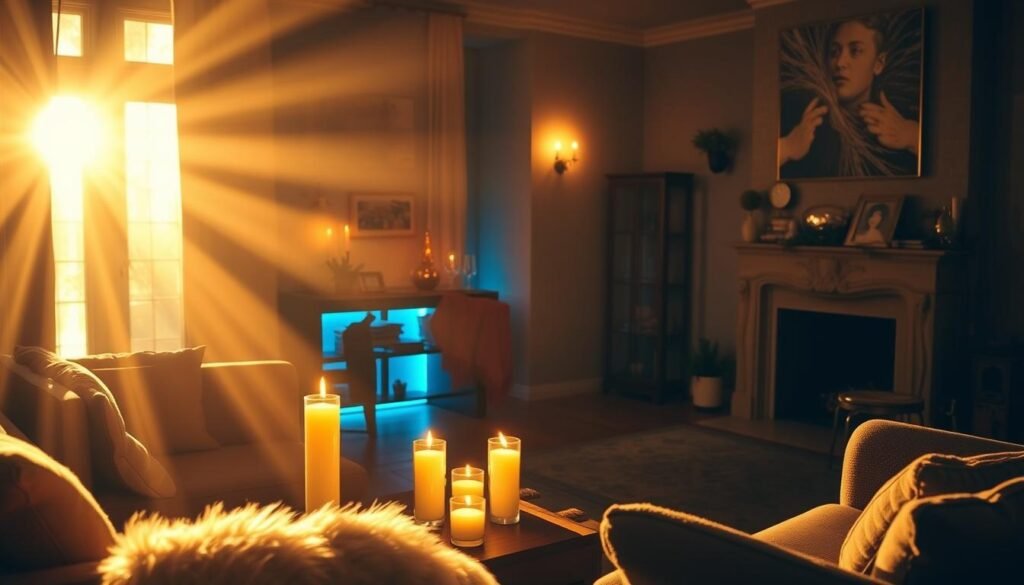
Understanding color temperature’s impact on mood and atmosphere helps you choose the right lighting. Whether you want a cozy or bright space, you can achieve it with the right lighting choices.
Energy-Efficient Lighting Solutions
Using energy-efficient lighting in your home is great for the planet and can save you money. Smart lighting and lighting control systems help save energy and make your home look and feel better.
LED lights are a big step towards saving energy. They use much less power than old bulbs and last a lot longer. Switching to LEDs can save a family about $225 each year, which is a big savings over time.
Adding smart controls to your lights can save even more energy. Dimmers, timers, and motion sensors adjust lights automatically. This means lights only use energy when someone is in the room.
Using smart home technology in your lights takes energy saving to the next level. These systems let you set light schedules, create scenes, and control lights from anywhere. This ensures your lights are always right and saves energy.
For outdoor lights, LED flood lights with sensors are a smart choice. They save energy and provide security. Solar-powered lights are another green option for outdoor use.
Choosing energy-efficient lighting not only cuts down on carbon emissions but also saves you money on bills. Smart lighting technology makes your home more eco-friendly and stylish.
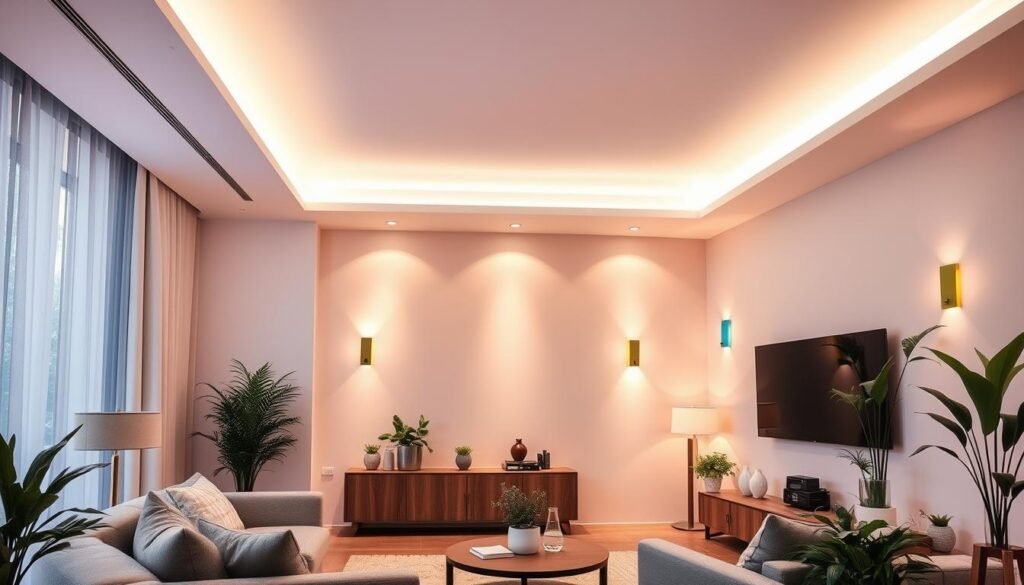
“Lighting typically accounts for around 15% of an average home’s electricity use. By switching to energy-efficient lighting, homeowners can see significant savings on their energy bills.” – Energy Efficiency Expert
Creating Focal Points with Accent Lighting
Accent lighting is a powerful tool for making any space look better. It highlights architectural features or artwork, creating captivating focal points. These add depth, character, and drama to your interior design.
Whether it’s a textured wall, a unique ceiling, or a prized piece of art, the right lighting makes a big difference.
Highlighting Architectural Features
Chandeliers, pendant lights, and other statement fixtures can be the room’s focal point. They draw the eye and add elegance. For example, the Aalto 53 Inch 12 Light LED Linear Suspension Light by Hammerton Studio combines industrial and classical styles.
This creates a visually striking focal point that complements modern furniture and décor.
Artwork and Display Lighting
Carefully placed accent lighting can highlight artwork, sculptures, or displays. It creates a sense of depth and drama. Picture lights or track lighting systems can be placed to draw attention to specific pieces.
This unifies the room’s design and adds flair to the décor. By layering different light sources, you can create a visually compelling environment that captivates the senses.
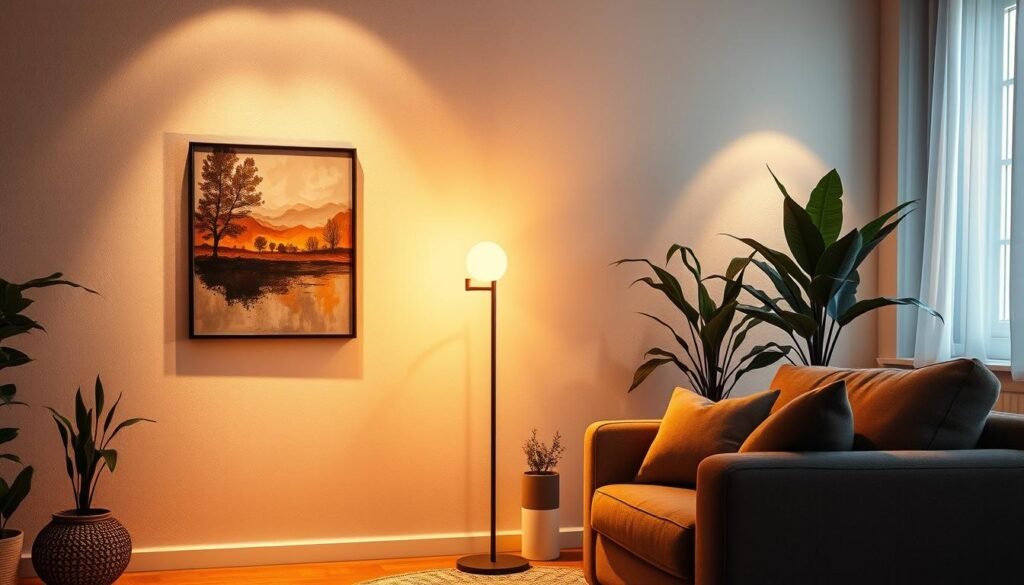
Incorporating accent lighting into your overall illumination design is a surefire way to create focal points. Whether highlighting architectural features or showing off your art collection, the right accent lighting and illumination design can transform any room into a visually stunning masterpiece.
Layering Light Sources for Depth
Creating the perfect ambiance in any space is all about mastering layered lighting. By combining ambient lighting, task lighting, and accent lighting strategically, you can add depth and interest. This makes the space welcoming and adaptable to your needs.
Ambient lighting sets the base, lighting up the room. It includes fixtures like pendant lights, chandeliers, and ceiling panels. These provide a soft glow everywhere. Task lighting focuses on specific tasks, like reading or cooking. Floor lamps, desk lamps, and vanity lights help by removing shadows and improving visibility.
Accent lighting adds drama and highlights important features. Wall sconces, track lighting, and LED strips draw attention to details, artwork, or decorations. This creates depth and visual appeal.
| Lighting Type | Purpose | Examples |
|---|---|---|
| Ambient Lighting | Provides overall illumination | Pendants, chandeliers, ceiling panels |
| Task Lighting | Focuses on specific activities | Floor lamps, desk lamps, vanity lights |
| Accent Lighting | Highlights key features | Wall sconces, track lighting, LED strips |
By layering these three lighting types, you can create a balanced and versatile design. The goal is to find the right mix. Each layer should enhance the others and the overall feel of the space.
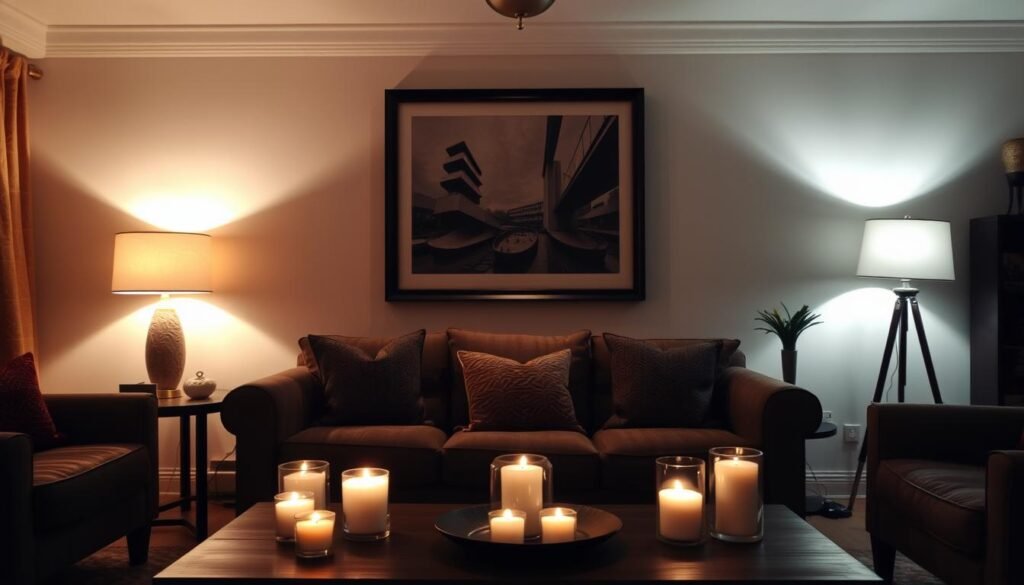
“Lighting is the hidden hero of interior design. It can transform a space, set the mood, and bring a room to life.”
The Role of Dimmers and Controls
Dimmers and advanced lighting controls are key to setting the mood in any room. They let you change the light’s intensity, making a room bright or cozy. With dimmer switches and smart systems, you can easily adjust the atmosphere to fit your mood.
Smart Controls and Automation
Lighting technology has advanced to include smart controls and automation. Today’s systems offer more than just dimming. Smart lighting lets you create light scenes and control them with a button or voice. These systems improve ambiance and save energy by using only needed light.
Programming Light Scenes
Modern lighting control systems let you program light scenes for different occasions. Whether it’s for a dinner party or a romantic evening, you can save lighting setups. With a few taps or a voice command, your space’s lighting can change instantly.
Dimmers and controls bring flexibility to lighting. They let you create the perfect atmosphere for any moment. Your space can become a cozy and stylish haven with these tools.
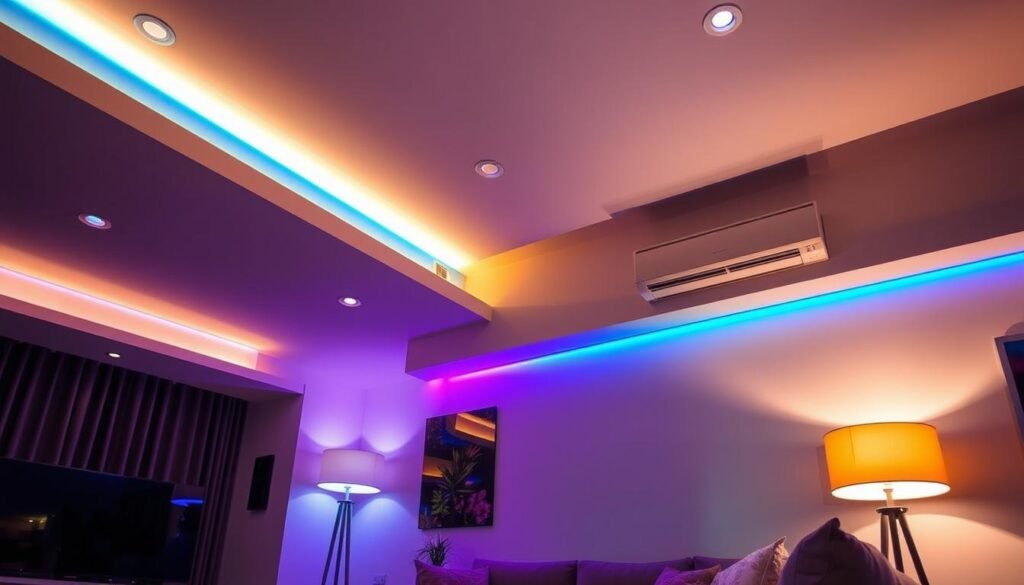
“Lighting has the power to set the mood and atmosphere of a room. With the right dimmer switches and control systems, you can create a customized lighting experience that enhances your living space.”
Outdoor Lighting Considerations
Outdoor lighting is key for safety, security, and ambiance. It lights up paths, highlights buildings, and makes outdoor spaces welcoming. Good planning and execution are vital for these effects.
When choosing outdoor lighting, think about weatherproofing and durability. It must handle the weather. Also, energy efficiency is important for your bills and the planet. Plus, it’s vital to avoid light pollution and follow local rules.
Lighting Techniques and Fixture Types
Outdoor lighting uses many techniques like uplighting and downlighting. These are done with various fixtures like path lights and spotlights. Each has its own role, from lighting paths to adding warmth.
| Lighting Technique | Purpose | Fixture Types |
|---|---|---|
| Uplighting | Accentuate architectural elements or landscape features | Spotlights, well lights |
| Downlighting | Provide functional lighting for pathways and entrances | Pathway lights, deck and step lights |
| Cross Lighting | Create depth and dimension in outdoor spaces | Wall lights, post lights |
| Silhouetting | Highlight the outline of objects or landscape features | Landscape lighting, bullet lights |
| Accent Lighting | Add visual interest and draw attention to specific elements | Spotlights, wash lights, floodlights |
Planning and budgeting are key for outdoor lighting. The cost can vary a lot based on the design and fixtures.
For a successful outdoor lighting project, consider getting help from experts. They can guide you through options and ensure your design meets your needs.
Budget-Friendly Lighting Updates
Updating your home’s lighting doesn’t have to cost a lot. With some creativity and smart choices, you can refresh your space without spending too much.
DIY Lighting Projects
Try your hand at DIY lighting projects. Fixing up old light fixtures or making new lamp shades is both fun and budget-friendly. Look for cheap items at thrift stores, garage sales, and online to give them a new life.
Cost-Effective Solutions
- Buy LED light bulbs – they might cost more at first, but they save money on energy bills later.
- Get dimmer switches to change the mood of your lights. This small change can greatly improve a room’s feel.
- Use mirrors to make rooms look brighter and bigger. They can reflect light and make spaces feel more open.
| Product | Price |
|---|---|
| Mercer41 Dimmable Floor Lamp at Wayfair | $79 |
| AllModern Davita 3 Chandelier at Wayfair | $299 |
| Magnetic Motion Sensor Lights at Amazon | $24 |
| EDISHINE Tripod Table Lamp at Amazon | $30 |
| Handmade Chandelier on Etsy | $405 |
With these budget-friendly ideas, you can change your home’s feel without spending a lot. A bit of creativity and smart planning can help you get the lighting just right for your space.
Troubleshooting Common Lighting Issues
Getting the right lighting in your space can be tricky. Issues like glare, uneven lighting, and smart home problems can pop up. Knowing what causes these problems and how to fix them helps create a bright and welcoming area.
Glare often comes from lights that are too bright or not placed right. Using diffusers or adjusting shades can help soften the light. Also, moving fixtures around can reduce glare.
Uneven lighting can make some spots too bright and others too dark. This might be because of bad task lighting or poor layout. Adding more lights or moving fixtures can fix this.
Smart lighting control systems can have their own problems. These might include connectivity issues or sensor problems. Flickering lights could mean electrical issues, like bad bulbs or wiring problems, and might need a pro to fix.
Keeping your lights in good shape and knowing about illumination design can prevent many issues. Replacing old fixtures, changing light colors, and using the right bulbs are key to a smooth system.
“Proper lighting can transform a space, but troubleshooting issues is key to maintaining the perfect ambiance.”
By tackling these common lighting problems, you can make your space look great and work well. A few tweaks and the right help can make your lighting system shine.
Maintenance and Care for Lighting Systems
Keeping your light fixtures and smart lighting systems in top shape is key. Regular cleaning, timely bulb changes, and checking wiring are musts. These steps can make your lighting last longer and work better.
For smart lighting, it’s important to update software and keep connections strong. Knowing how to care for different lights, like LEDs, helps them look and work great for longer.
- Regularly clean your light fixtures to avoid dust and debris. This keeps light output high and energy use low.
- Swap out bulbs when they start to fade or burn out. This keeps your lighting steady and avoids any work slowdowns.
- Check wiring and connections often. This helps spot and fix problems early, preventing lights from going out.
- Keep your smart lighting up-to-date with the latest maintenance tips. This ensures it works well and stays compatible with new tech.
Getting a professional to handle lighting upkeep can save you money. They bring their know-how and make it easier for you. Plus, they can offer custom solutions that fit your needs, making your lighting systems more efficient and lasting longer.
| Maintenance Task | Frequency | Benefits |
|---|---|---|
| Fixture Cleaning | Bi-Annually | Improves light output, enhances energy efficiency |
| Bulb Replacement | As Needed | Maintains consistent lighting levels, prevents productivity disruptions |
| Wiring Inspection | Annually | Identifies and addresses possible issues, prevents lighting failures |
| Smart Lighting Updates | Quarterly | Ensures optimal performance and compatibility with new technologies |
By taking a proactive stance on lighting upkeep, you can make your light fixtures and smart lighting systems last longer. You’ll also boost their energy efficiency. This leads to a greener, more cost-effective, and productive workspace.
Conclusion
Creating the perfect lighting and ambiance for your space is all about understanding lighting design. It’s about thinking about each room’s needs and finding a balance between function and beauty. By mixing different types of lighting and using natural light, you can make any space welcoming and beautiful.
Lighting is key in setting the mood and feel of a home. It can make a bedroom cozy or a kitchen bright and lively. Learning how to use lighting well can make your home more than just a place to live. It can become a space that feels special and looks amazing.
Whether you want to show off your home’s features or create a calm atmosphere, the right lighting is essential. Keeping up with new lighting trends and technologies can help you create spaces that are truly yours. Your home can become a reflection of your style and vision.
FAQ
What are the essential types of interior lighting?
There are three main types of interior lighting. Task lighting focuses on specific activities. Accent lighting highlights certain features or objects. Ambient lighting provides overall illumination and sets the mood.
How can I create the perfect lighting and ambiance for different rooms in my home?
Living rooms need a mix of ambient and accent lighting for a cozy feel. Bedrooms should have soft, adjustable lighting for relaxation. Kitchens and dining areas require bright task lighting for food prep and softer ambient lighting for dining.
Using dimmer switches and layering different light sources helps create the right ambiance. This makes your home versatile and inviting.
What are the benefits of smart lighting systems?
Smart lighting systems offer advanced control and customization. You can adjust brightness, color temperature, and create scenes for different activities or moods. They also help save energy by optimizing light usage based on occupancy or time of day.
How can I integrate natural light and balance it with artificial lighting?
Natural light is key to a well-lit space. Use sheer curtains, position mirrors, and observe light movement to optimize natural light. Balancing natural and artificial light involves adjusting artificial lighting to complement natural light conditions.
How does color temperature affect the mood and atmosphere of a space?
Warm lighting (2700K-3000K) creates a cozy, inviting feel, perfect for living rooms and bedrooms. Cool lighting (3500K-4100K) is better for task-oriented areas like kitchens and offices. Adjusting lighting seasonally helps maintain a comfortable atmosphere year-round.
What are some budget-friendly lighting updates I can make?
Save money by using LED bulbs for energy savings and installing dimmer switches for versatility. Strategically place mirrors to amplify existing light. DIY projects like refurbishing old fixtures or creating custom lamp shades can also refresh your space on a budget.
How can I troubleshoot common lighting issues?
For glare, uneven illumination, or inadequate task lighting, adjust fixture placement or use diffusers. Adding supplementary lighting sources can also help. For smart lighting systems, check connectivity issues or recalibrate sensors to troubleshoot.
How do I maintain and care for my lighting system?
Proper maintenance ensures your lighting system lasts long and works well. Clean fixtures regularly, replace bulbs on time, and check wiring and connections. For smart lighting systems, keep software updated and ensure proper connectivity.


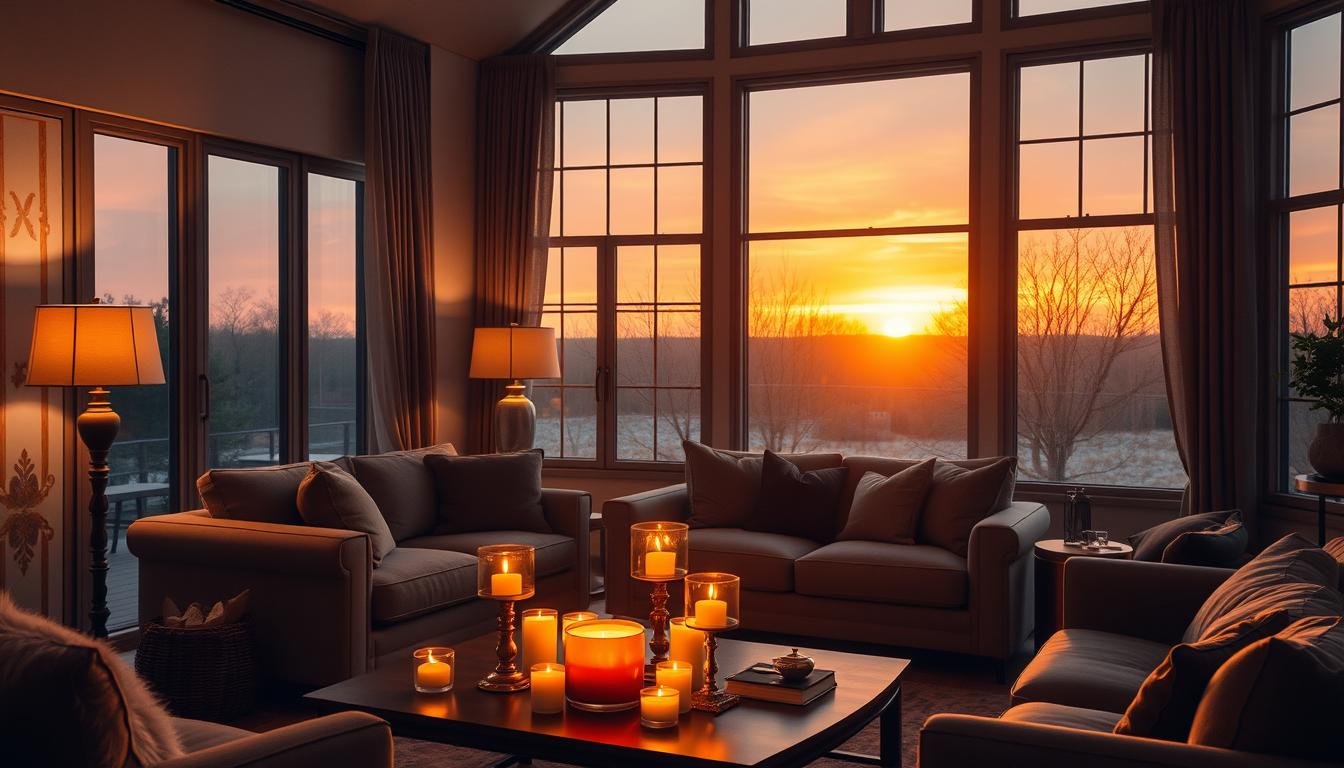
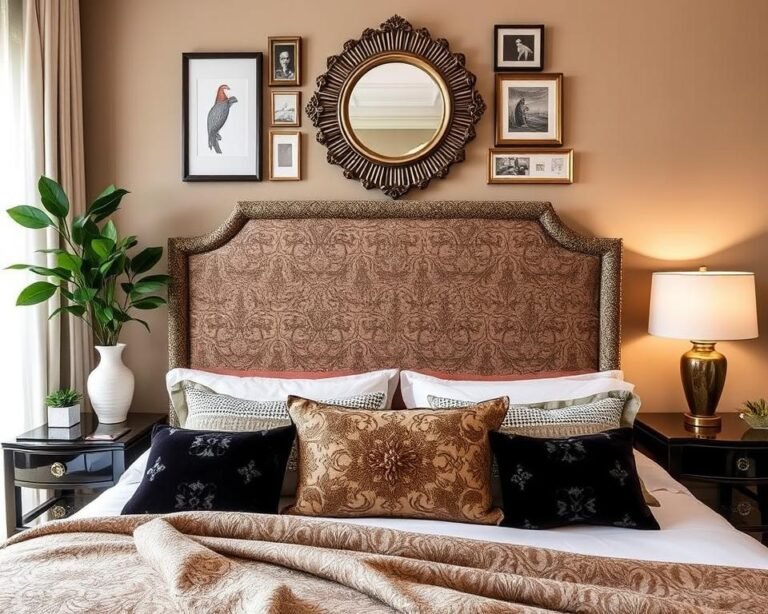

Leave a Comment